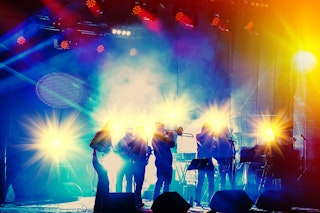Women in Tri‑Cities STEM Tourism
The Tri-Cities has a rich history steeped in STEM (Science, Technology, Engineering, Mathematics) in some of the world’s foremost scientific discoveries and events.
From the Ice Age Floods that carved out the Tri-Cities' unique topography making way for agriculture (wine anyone?), to the Columbia River creating the proper environment for the top-secret Manhattan Project, to the award-winning discovery of gravitational waves at the Laser Interferometer Gravitational-Wave Observatory (LIGO) and beyond. The Tri-Cities is an epicenter of scientific awesomeness—all of which can be enjoyed by visitors. What else do these marvels have in common?
Women.
From prolific scientists and engineers to innovative drivers of progress, women have helped shape the scientific community that the Tri-Cities is today. Meet a few of the women who are passionate about STEM tourism assets and initiatives in the Tri-Cities.
Becky Burghart
Site Manager
Manhattan Project National Historical Park, Hanford
As the Site Manager for the Hanford Unit of the Manhattan Project National Historical Park, Becky Burghart leads the National Park Service presence in Tri-Cities, Washington. A primary focus for Becky is collaborating with park staff and partners to ensure the park shares the broad story of the Manhattan Project and creates opportunities for visitors of all ages and backgrounds to connect to the profound history and legacies of the Manhattan Project.
Becky has worked with the National Park Service for 20 years. Before her current position, she spent eight years at White Sands National Park as the Interpretation Program Manager. She has also worked in interpretation at Chamizal National Memorial and Grand Teton and Mesa Verde national parks. She holds an MS in Conservation Social Science from the University of Idaho and served as a Peace Corps Volunteer in Ecuador.
In 1942, the US government created the top-secret Manhattan Project to develop the world’s first atomic weapons. Women were instrumental in the success of the project, but most women worked in secretarial or similar positions. At Hanford, women made up nine percent of the workforce, one percent of the supervisors, and only one woman-- Leona Woods Marshall Libby–was on the team that built the world’s first nuclear reactor and oversaw the B Reactor at Hanford. Career opportunities for women in STEM fields were very limited at that time. Women like Leona Libby, Marie Curie, and Lise Meitner created opportunities for future generations of women to excel in STEM careers. But much work remains today as women continue to remain underrepresented in the science, computing, and engineering job fields.

Colleen French
Program Manager
Manhattan Project National Historical Park, Hanford
U.S. Department of Energy, Richland Operations Office
Colleen French had never heard of the Hanford Site when she moved to the Tri-Cities in 1992 for her first job in television journalism. She quickly “geeked out” on Hanford’s unique convergence of history, science, politics, technology, public policy, and the environment. She joined the site in 1995 supporting communications and went on to lead the Richland office’s communications, congressional affairs, and intergovernmental functions for the U.S. Department of Energy (DOE). But her dream opportunity came in 2008, after she helped wrangle behind the scenes to save Hanford’s B Reactor from destruction, and ended up managing its preservation and the start of widespread public access.
B Reactor is the world’s first full-scale nuclear production reactor. It was constructed as part of the Manhattan Project, the top-secret race to beat Nazi Germany to the atomic bomb during WWII. Now open to visitors seasonally as part of the Manhattan Project National Historical Park, B Reactor is a quintessential STEM achievement. Starting in 1943, workers made breakthroughs in mathematics and science that enabled the splitting of the atom to create new isotopes for weapons and were able to engineer, construct, and start the facility to produce those isotopes in just 11 months.
Visitors have come from more than 50 states and 90 countries worldwide to stare in awe at B Reactor’s exposed front face and learn about the start of the atomic age. French points out that a female engineer was part of the management team overseeing B Reactor’s construction and was present when the reactor was started up for the first time in 1944. It’s one of the ways B Reactor underscores the importance of recruiting and enabling current and future generations of STEM achievers without regard to gender. STEM is about problem-solving, discovery, expanding the boundaries of knowledge and capability, and asking the right questions to figure out what is possible.

Diahann Howard
Executive Director
Port of Benton, USS Triton Sail Park
Diahann Howard was named Port of Benton Executive Director in late 2019. She began her career with the Port in 2006 as Director of Economic Development & Governmental Affairs. Howard is the first female named to the Port of Benton Executive Director position and the first Executive Director with Latina heritage among the 75 Port districts within Washington state.
While at the Port, Howard has served as the Tri-Cities Research District Executive Director (2007-2019) and Richland Rotary President (2017-2018). She was named 2011 – 2012 Rotarian of the Year and, in 2019, was awarded a Professional Port Manager (PPM®) certification from the American Public Ports Association. Howard has served as a member of the U.S. Department of Energy Management Advisory Board, Mid-Columbia Energy Initiative, Visit Tri-Cities Board of Directors, Hanford Communities, and the Manhattan Project National Historical Park Committee.
“I am inspired by the accomplishments and strength of the women in the Tri-Cities area,” stated Howard. “Our region is home to many influential women in STEM-related industries, which has created a robust and valuable network for STEM professionals and those interested in pursuing STEM careers.”
Port of Benton established the USS Triton Sail Park in 2011. The park is located at 3250 Port of Benton Blvd. in Richland and features the decommissioned submarine’s 75-foot-long sail and conning tower. The USS Triton made history in 1960 as the first submarine to circle the earth underwater, following the path of explorer Ferdinand Magellan. The top-secret military Cold War mission code-named Operation Sandblast would demonstrate the capabilities of the first generation of nuclear-powered submarines and gather unprecedented scientific data. Visit the park’s public spaces or contact the Port for a tour inside the submarine’s conning tower, where the original instrumentation is still in place.
Other Notable Tri-Cities Women in STEM Tourism:
Rosanna Sharpe, Executive Director of the REACH Museum
With more than 30 years of museum experience, Rosanna knows how to share the stories of significant people and places. Since 2017, Rosanna has been leading the REACH Museum in Richland, which shares the ongoing story of the Tri-Cities and the surrounding area. Named after the Hanford Reach, the longest free-flowing section of the Columbia River, the entire campus tells stories about the importance of the river to the community with four anchor galleries featuring natural history, agriculture, the Manhattan Project, and the Cold War.
Erin Steinert, Director of the CPCCo Planetarium and the Robert & Elisabeth Moore Observatory at Columbia Basin College
Erin has been involved in the informal science education arena for more than 17 years, with a focus on astronomy and space science—making her a great fit to lead programming for the CPCCo Planetarium and the Robert & Elisabeth Moore Observatory at Columbia Basin Columbia in Pasco. The Planetarium offers an “out of this world experience” through life-like, high-definition images, and sound using the most state-of-the-art projection system in the Pacific Northwest. The 36-foot panoramic viewing dome can simulate a multi-dimensional effect without any 3D glasses.
Amber Strunk, Education and Public Outreach at LIGO Hanford Observatory
Amber is responsible for sparking interest and inspiring future generations to engage in astrophysics. Amber educates the public on the work of the Laser Interferometer Gravitational-Wave Observatory or LIGO, which was designed to open the field of gravitational-wave astrophysics through the direct detection of gravitational waves predicted by Einstein’s General Theory of Relativity.
The LIGO Exploration Center (LExC), host visitors to learn more about the work of the LIGO Hanford Observatory. LExC is located at the observatory, a giant L-shaped detector outside of Richland.
An Honorable Mention: PNNL Shaping Our Community
While national laboratories may not be traditional tourist attractions, they often serve as the backbone of their communities. PNNL is no exception in shaping the livability and appeal of the Tri-Cities. Originally founded to support nuclear technology development, PNNL has diversified its research portfolio into scientific disciplines such as environmental science, cybersecurity, materials science, and renewable energy. Its historical and groundbreaking work has been integral to the community's identity and progress. Despite not being a conventional tourism asset, PNNL's contributions are deeply ingrained in the Tri-Cities' history and development, making it an essential part of what makes our community thrive.
See how the women of PNNL are shaping our communities' wind distribution, international nuclear security, mathematics, engineering, and much more.
Recommended Reading Beyond This Post...
Tri-IDEAs is a program exploring and celebrating Inclusivity, Diversity, Equity and Accessibility through tourism in the Tri-Cities.






































